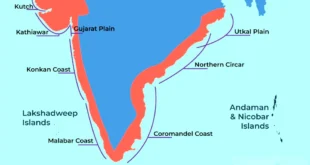GS-1
SOLAR ROTATION
Kodaikanal Solar Observatory Digitized Data probes Sun’s rotation over the century.
Who conducted the study?
- Researchers led by a Ph.D. student from the Aryabhatta Research Institute of Observational Sciences (ARIES), an autonomous institute under Department of Science and Technology (DST), Govt. of India
- Collaborators from Max Planck Institute for Solar System Research, Goettingen, Germany.
- Collaborators from Southwest Research Institute, Boulder, USA. The researchers studied the solar rotation by tracing sun spots from century-old digitalized films and photographs.
- The old films and photographs were taken at the Kodaikanal Solar Observatory (KoSO) of the Indian Institute of Astrophysics (Bengaluru).
- This estimation would help study magnetic field generated in the interior of the Sun, which causes sunspots and results in extreme situations like the historical mini-ice age on Earth (absence of sunspots).
- It could also help predict solar cycles and their variations in the future.
Solar rotation:
- The Sun rotates more quickly at its equator than at its poles.
- Over time, the Sun’s differential rotation rates cause its magnetic field to become twisted and tangled.
- The tangles in the magnetic field lines can produce strong localized magnetic fields.
- When the Sun’s magnetic field gets twisted, there are lots of sunspots.
- The sunspots which form at the surface with an 11-year periodicity are the only route to probe the solar dynamo or solar magnetism inside the Sun and hence measure the variation in solar rotation.
- The solar rotation period is 24.47 days at the equator and almost 38 days at the poles. The average rotation is 28 days.
SOURCE: DTE
 Chinmaya IAS Academy – Current Affairs Chinmaya IAS Academy – Current Affairs
Chinmaya IAS Academy – Current Affairs Chinmaya IAS Academy – Current Affairs



